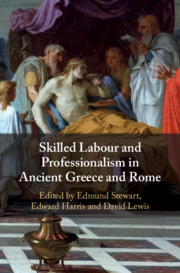Book contents
- Skilled Labour and Professionalism in Ancient Greece and Rome
- Skilled Labour and Professionalism in Ancient Greece and Rome
- Copyright page
- Contents
- Illustrations
- Contributors
- Acknowledgements
- Abbreviations
- Introduction
- Part I Professionals and Professional Identity in Greece and Rome
- Part II Specialization and the Division of Labour in the Ancient City
- Part III Case Studies of Professions 1: Sculpture
- Part IV Case Studies of Professions 2: Music and Athletics
- Part V Case Studies of Professions 3: A Profession of Arms?
- 12 Professionalism, Specialization, and Skill in the Classical Spartan Army?
- 13 A Professional Roman Army?
- Index
- References
12 - Professionalism, Specialization, and Skill in the Classical Spartan Army?
from Part V - Case Studies of Professions 3: A Profession of Arms?
Published online by Cambridge University Press: 18 September 2020
- Skilled Labour and Professionalism in Ancient Greece and Rome
- Skilled Labour and Professionalism in Ancient Greece and Rome
- Copyright page
- Contents
- Illustrations
- Contributors
- Acknowledgements
- Abbreviations
- Introduction
- Part I Professionals and Professional Identity in Greece and Rome
- Part II Specialization and the Division of Labour in the Ancient City
- Part III Case Studies of Professions 1: Sculpture
- Part IV Case Studies of Professions 2: Music and Athletics
- Part V Case Studies of Professions 3: A Profession of Arms?
- 12 Professionalism, Specialization, and Skill in the Classical Spartan Army?
- 13 A Professional Roman Army?
- Index
- References
Summary
Contrary to orthodox views, Sparta’s full citizens, the Spartiates, were not professional or specialized full-time soldiers and, apart from practice in elementary drill, their training focused mainly on physical fitness. In so far as Sparta’s armies excelled in technical proficiency, it was through their tight-knit organization and hierarchical command structures and their methodical, if often inflexible, implementation of set manoeuvres.
- Type
- Chapter
- Information
- Skilled Labour and Professionalism in Ancient Greece and Rome , pp. 335 - 361Publisher: Cambridge University PressPrint publication year: 2020
References
- 1
- Cited by

